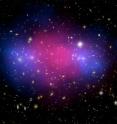A clash of clusters provides another clue to dark matter
Related images
(click to enlarge)
A powerful collision of galaxy clusters has been captured with NASA's Chandra X-ray Observatory and Hubble Space Telescope. Like its famous cousin, the so-called Bullet Cluster, this clash of clusters provides striking evidence for dark matter and insight into its properties. Like the Bullet Cluster, this newly studied cluster, officially known as MACSJ0025.4-1222, shows a clear separation between dark and ordinary matter. This helps answer a crucial question about whether dark matter interacts with itself in ways other than via gravitational forces.
This finding is important because it independently verifies the results found for the Bullet Cluster in 2006. The new results show the Bullet Cluster is not an exception and that the earlier results were not the product of some unknown error.
Just like the original Bullet Cluster, MACSJ0025 formed after an incredibly energetic collision between two large clusters in almost the plane of the sky. In some ways, MACSJ0025 can be thought of as a prequel to the Bullet Cluster. At its much larger distance of 5.7 billion light years, astronomers are witnessing a collision that occurred long before the Bullet Cluster's.
Using optical images from Hubble, the team was able to infer the distribution of the total mass (colored in blue) -- dark and ordinary matter -- using a technique known as gravitational lensing. The Chandra data enabled the astronomers to accurately map the position of the ordinary matter, mostly in the form of hot gas, which glows brightly in X-rays (pink).
An important difference between the Bullet Cluster and the new system is that MACSJ0025 does not actually contain a "bullet". This feature is a dense, X-ray bright core of gas that can be seen moving through the Bullet Cluster. Nonetheless, the amount of energy involved in this mammoth collision is nearly as extreme as that found in the Bullet Cluster.
As the two clusters that formed MACSJ0025 (each almost a whopping million billion times the mass of the Sun) merged at speeds of millions of miles per hour, the hot gas in each cluster collided and slowed down, but the dark matter did not. The separation between the material shown in pink and blue therefore provides direct evidence for dark matter and supports the view that dark matter particles interact with each other only very weakly or not at all, apart from the pull of gravity.
One of the great accomplishments of modern astronomy has been to establish a complete inventory of the matter and energy content of the Universe. The so-called dark matter makes up approximately 23% of this content, five times more than the ordinary matter that can be detected by telescopes. The latest results with MACSJ0025 once again confirm these findings.
Source: Chandra X-ray Center
Articles on the same topic
- Collision of galaxy clusters captured by astronomersWed, 27 Aug 2008, 18:28:28 UTC
- Hubble and Chandra composite of the galaxy cluster MACS J0025.4-1222Wed, 27 Aug 2008, 15:15:23 UTC
- How do galaxies grow?Tue, 26 Aug 2008, 14:15:25 UTC
Other sources
- Colliding galaxies shed light on dark matterfrom Reuters:ScienceWed, 27 Aug 2008, 23:00:08 UTC
- Powerful Cosmic Collision Creates Divorce of Matterfrom Space.comWed, 27 Aug 2008, 20:28:06 UTC
- PHOTO IN THE NEWS: Cluster Smashup Is Dark Matter Prooffrom National GeographicWed, 27 Aug 2008, 18:49:05 UTC
- Collision of galaxy clusters captured by astronomersfrom Science BlogWed, 27 Aug 2008, 18:28:07 UTC
- SPACE PHOTOS THIS WEEK: Massive Galaxy Cluster, Morefrom National GeographicWed, 27 Aug 2008, 17:42:04 UTC
- Galaxy Surprise Sheds Light on Dark Matterfrom Space.comWed, 27 Aug 2008, 17:07:09 UTC
- A Clash of Clusters Provides Another Clue to Dark Matterfrom Newswise - ScinewsWed, 27 Aug 2008, 15:35:28 UTC
- A clash of clusters provides another clue to dark matterfrom PhysorgWed, 27 Aug 2008, 15:35:23 UTC
- Clash Of Clusters Provides New Dark Matter Cluefrom Science DailyWed, 27 Aug 2008, 15:35:06 UTC
- A Clash of Clusters Provides New Clue to Dark Matterfrom Newswise - ScinewsWed, 27 Aug 2008, 14:28:12 UTC
- How Do Galaxies Grow? Massive Galaxies Caught In The Act Of Mergingfrom Science DailyTue, 26 Aug 2008, 13:21:10 UTC
- Giant cluster of galaxies is discoveredfrom UPIMon, 25 Aug 2008, 19:56:11 UTC
- XMM-Newton's massive discoveryfrom PhysorgMon, 25 Aug 2008, 18:14:23 UTC
- Giant Galaxy Cluster Seen in Early Universefrom Space.comMon, 25 Aug 2008, 16:21:22 UTC
- Giant Galaxy Cluster Seen in Early Universefrom Live ScienceMon, 25 Aug 2008, 16:21:15 UTC
- XMM-Newton’s massive discoveryfrom European Space AgencyMon, 25 Aug 2008, 8:07:17 UTC
